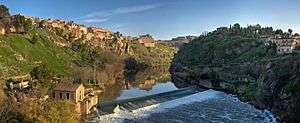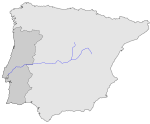Tagus
| Tagus River | |
| Tajo, Tejo | |
 View of Tagus River in Toledo, Spain | |
| Countries | Spain, Portugal |
|---|---|
| Tributaries | |
| - left | Guadiela, Algodor, Gévalo, Ibor, Almonte, Salor, Sever, Sorraia |
| - right | Gallo, Jarama, Guadarrama, Alberche, Tiétar, Alagón, Zêzere |
| Source | Fuente de García |
| - location | Montes Universales, Sierra de Albarracín Comarca, Teruel, Aragon, Spain |
| - elevation | 1,593 m (5,226 ft) |
| Mouth | Estuary of the Tagus |
| - location | Atlantic Ocean near Lisbon, Portugal |
| - elevation | 0 m (0 ft) |
| Length | 1,038 km (645 mi) |
| Basin | 80,100 km2 (30,927 sq mi) |
| Discharge | |
| - average | 500 m3/s (17,657 cu ft/s) |
 Path of the Tagus through the Iberian Peninsula | |
| Wikimedia Commons: Tagus | |
| Website: Confederación Hidrográfica del Tajo | |


The Tagus (Spanish: Tajo [ˈtaxo]; Portuguese: Tejo [ˈtɛʒu]; Latin: Tagus; Ancient Greek: Τάγος Tagos) is the longest river on the Iberian Peninsula. It is 1,038 km (645 mi) long, 716 km (445 mi) in Spain, 47 km (29 mi) along the border between Portugal and Spain and 275 km (171 mi) in Portugal, where it empties into the Atlantic Ocean near Lisbon. It drains an area of 80,100 square kilometers (30,927 sq mi) (the second largest in the Iberian peninsula after the Douro). The Tagus is highly utilized for most of its course. Several dams and diversions supply drinking water to most of central Spain, including Madrid, and Portugal, while dozens of hydroelectric stations create power. Between dams it follows a very constricted course, but after Almourol it enters a vast alluvial valley prone to flooding. At its mouth is a large estuary on which the port city of Lisbon is situated.
The source of the Tagus is the Fuente de García, in the Frías de Albarracín municipal term, Montes Universales, Sistema Ibérico, Sierra de Albarracín Comarca. All its major tributaries enter the Tagus from the right (north) bank. The main cities it passes through are Aranjuez, Toledo, Talavera de la Reina and Alcántara in Spain, and Abrantes, Santarém, Almada and Lisbon in Portugal.
Course
In Spain

The first notable city on the Tagus is Sacedón. Below Aranjuez it receives the combined flow of the Jarama, Henares, Algodor and Tajuña. Below Toledo it receives the Guadarrama River. Above Talavera de la Reina it receives the Alberche. At Valdeverdeja is the upper end of the long upper reservoir, the Embalse de Valdecañas, beyond which are the Embalse de Torrejon, into which flow the Tiétar, and the lower reservoir, the Alcántara Dam into which flows the Alagón at the lower end.
There is a canal and aqueduct between the Tagus and the Segura.
In Portugal
After forming the border it enters Portugal, passing Vila Velha de Ródão, Abrantes, Constância, Entroncamento, Santarém and Vila Franca de Xira at the head of the long narrow estuary, which has Lisbon at its mouth. The estuary is protected by the Tagus Estuary Natural Reserve. There is the largest bridge across the river, the Vasco da Gama Bridge, which with a total length of 17.2 km (10.7 mi) is the longest bridge in Europe.
The Portuguese Alentejo region and former Ribatejo Province take their names from the river; Alentejo, from além Tejo "Beyond the Tagus" and Ribatejo from arriba Tejo, an archaic way of saying "Upper Tagus".
Geology
The lower Tagus is on a fault line. Slippage along it has caused numerous earthquakes, the major ones being those of 1309, 1531 and 1755.[1]
History
The Pepper Wreck, properly the wreck of the Nossa Senhora dos Mártires, is a shipwreck located and excavated at the mouth of the Tagus between 1996 and 2001.
The river had strategic value to the Spanish and Portuguese empires, as it guarded the approach to Lisbon. For example, in 1587, Sir Francis Drake briefly approached the river after his successful raid at Cadiz.[2]
Popular culture
A major river, the Tagus is brought to mind in the songs and stories of the Portuguese. A popular fado song in Lisbon notes that while people get older, the Tagus remains young ("My hair getting white, the Tagus is always young"). The author, Fernando Pessoa, wrote a poem that begins:
- "The Tagus is more beautiful than the river that flows through my village. But the Tagus is not more beautiful than the river that flows through my village..."[3]
Richard Crashaw's poem "Saint Mary Magdalene, or the Weeper" refers to the "Golden" Tagus as wanting Mary Magdalene's silver tears. In classical poetry the Tagus was famous for its gold-bearing sands (Catullus 29.19, Ovid, Amores, 1.15.34, Juvenal, Satires, 3.55, etc.).
See also
| Wikimedia Commons has media related to Tagus River. |
Notes
- ↑ Hobbs, William Herbert (1907). Earthquakes: An Introduction to Seismic Geology. NewYork: D. Appleton and Company. pp. 142–144. Downloadable Google Books
- ↑ Garrett Mattingly, The Armada, 118-119
- ↑ Pessoa, Fernando; Richard Zenith, Translator (1999). Fernando Pessoa and Co.: Selected Poems. Grove Press. p. 55. ISBN 9780802136275.
Coordinates: 40°19′11″N 1°41′51″W / 40.31972°N 1.69750°W